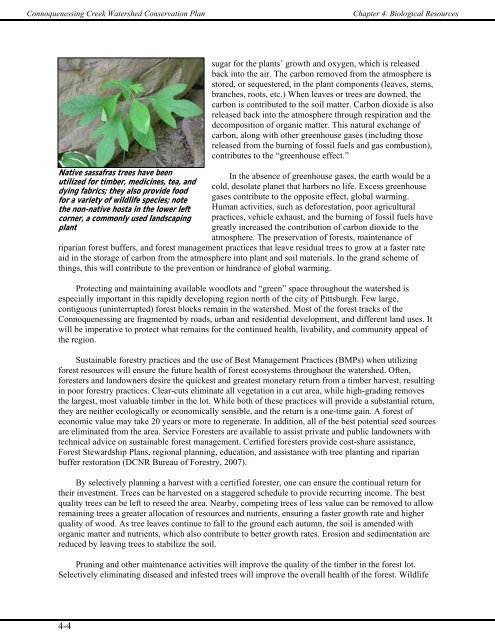CHAPTER 4 - Western Pennsylvania Conservancy
CHAPTER 4 - Western Pennsylvania Conservancy
CHAPTER 4 - Western Pennsylvania Conservancy
Create successful ePaper yourself
Turn your PDF publications into a flip-book with our unique Google optimized e-Paper software.
Connoquenessing Creek Watershed Conservation Plan<br />
Chapter 4. Biological Resources<br />
Native sassafras trees have been<br />
utilized for timber, medicines, tea, and<br />
dying fabrics; they also provide food<br />
for a variety of wildlife species; note<br />
the non-native hosta in the lower left<br />
corner, a commonly used landscaping<br />
plant<br />
sugar for the plants’ growth and oxygen, which is released<br />
back into the air. The carbon removed from the atmosphere is<br />
stored, or sequestered, in the plant components (leaves, stems,<br />
branches, roots, etc.) When leaves or trees are downed, the<br />
carbon is contributed to the soil matter. Carbon dioxide is also<br />
released back into the atmosphere through respiration and the<br />
decomposition of organic matter. This natural exchange of<br />
carbon, along with other greenhouse gases (including those<br />
released from the burning of fossil fuels and gas combustion),<br />
contributes to the “greenhouse effect.”<br />
In the absence of greenhouse gases, the earth would be a<br />
cold, desolate planet that harbors no life. Excess greenhouse<br />
gases contribute to the opposite effect, global warming.<br />
Human activities, such as deforestation, poor agricultural<br />
practices, vehicle exhaust, and the burning of fossil fuels have<br />
greatly increased the contribution of carbon dioxide to the<br />
atmosphere. The preservation of forests, maintenance of<br />
riparian forest buffers, and forest management practices that leave residual trees to grow at a faster rate<br />
aid in the storage of carbon from the atmosphere into plant and soil materials. In the grand scheme of<br />
things, this will contribute to the prevention or hindrance of global warming.<br />
Protecting and maintaining available woodlots and “green” space throughout the watershed is<br />
especially important in this rapidly developing region north of the city of Pittsburgh. Few large,<br />
contiguous (uninterrupted) forest blocks remain in the watershed. Most of the forest tracks of the<br />
Connoquenessing are fragmented by roads, urban and residential development, and different land uses. It<br />
will be imperative to protect what remains for the continued health, livability, and community appeal of<br />
the region.<br />
Sustainable forestry practices and the use of Best Management Practices (BMPs) when utilizing<br />
forest resources will ensure the future health of forest ecosystems throughout the watershed. Often,<br />
foresters and landowners desire the quickest and greatest monetary return from a timber harvest, resulting<br />
in poor forestry practices. Clear-cuts eliminate all vegetation in a cut area, while high-grading removes<br />
the largest, most valuable timber in the lot. While both of these practices will provide a substantial return,<br />
they are neither ecologically or economically sensible, and the return is a one-time gain. A forest of<br />
economic value may take 20 years or more to regenerate. In addition, all of the best potential seed sources<br />
are eliminated from the area. Service Foresters are available to assist private and public landowners with<br />
technical advice on sustainable forest management. Certified foresters provide cost-share assistance,<br />
Forest Stewardship Plans, regional planning, education, and assistance with tree planting and riparian<br />
buffer restoration (DCNR Bureau of Forestry, 2007).<br />
By selectively planning a harvest with a certified forester, one can ensure the continual return for<br />
their investment. Trees can be harvested on a staggered schedule to provide recurring income. The best<br />
quality trees can be left to reseed the area. Nearby, competing trees of less value can be removed to allow<br />
remaining trees a greater allocation of resources and nutrients, ensuring a faster growth rate and higher<br />
quality of wood. As tree leaves continue to fall to the ground each autumn, the soil is amended with<br />
organic matter and nutrients, which also contribute to better growth rates. Erosion and sedimentation are<br />
reduced by leaving trees to stabilize the soil.<br />
Pruning and other maintenance activities will improve the quality of the timber in the forest lot.<br />
Selectively eliminating diseased and infested trees will improve the overall health of the forest. Wildlife<br />
4-4














